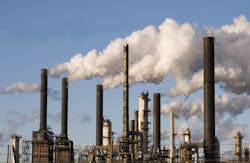The U.S. EPA is proposing standards that would reduce methane emissions from the oil and natural gas industry by up to 45 percent from 2012 levels over the next decade.
According to the EPA, methane, the key component of natural gas, is the second most prevalent greenhouse gas emitted in the U.S. from human activities, and nearly 30 percent of those emissions come from oil production and the production, transmission and distribution of natural gas.
The EPA proposed standards for new and modified sources are expected to reduce 340,000 to 400,000 short tons of methane in 2025, the equivalent of reducing 7.7 to 9 million metric tons of carbon dioxide. EPA estimates the rule will yield net climate benefits of $120 to $150 million in 2025. Those standards are also expected to reduce 170,000 to 180,000 tons of ozone-forming VOCs in 2025, along with 1,900 to 2,500 tons of air toxics, such as benzene, toluene, ethylbenzene and xylene.
READ ALSO: Emissions Monitoring Applications Propel Thermal Flowmeter Market
To cut emissions, the proposal, part of President Obama’s broader Climate Action Plan, requires:
- Finding and repairing leaks;
- Capturing natural gas from the completion of hydraulically fractured oil wells;
- Limiting emissions from new and modified pneumatic pumps; and
- Limiting emissions from several types of equipment used at natural gas transmission compressor stations, including compressors and pneumatic controllers.
As part of the proposed rules EPA announced Aug. 18, the agency is updating the 2012 New Source Performance Standards (NSPS) to address methane as well as VOC emissions for sources covered in that rule. EPA’s proposal would also require that industry reduce VOC and methane emissions from hydraulically fractured and refractured oil wells, which can contain significant amounts of natural gas along with oil.
In addition, the proposal means methane and VOC reductions "downstream" from wells and production sites, covering equipment in the natural gas transmission segment of the industry that was not regulated in the agency’s 2012 oil and natural gas rules. Additionally, the agency proposes to clarify and streamline Clean Air Act permitting requirements in states and Indian country.
In reaction to the EPA’s announcement, the American Petroleum Institute posted a statement on its website saying the EPA’s proposal for additional methane regulations on oil and gas wells and transmission are “duplicative, costly, and undermine America’s competitiveness.” The industry has already achieved significant reduction in methane through innovation and existing regulations, according to API President and CEO Jack Gerard.
"The oil and gas industry is leading the charge in reducing methane," Gerard said. "The last thing we need is more duplicative and costly regulation that could increase the cost of energy for Americans. Even as oil and natural gas production has surged, methane emissions from hydraulically fractured natural gas wells have fallen nearly 79 percent since 2005, and CO2 emissions are down to 27-year lows. This is due to industry leadership and significant investments in new technologies."
Total methane emissions from natural gas systems are down 11 percent since 2005—a direct result of industry innovation at the same time production has increased significantly, according to API. "API supports a common sense regulatory approach that builds on cost-effective controls already required by EPA for new equipment," Gerard said. "Combined with smart, voluntary efforts for existing sources, this approach will continue to lower methane emissions. To avoid undermining American competitiveness, we urge the EPA to coordinate its efforts and not add duplicative rules."
While API says the proposed standards are duplicative and costly, some industry associations, like the Fluid Sealing Association, a trade association that represents U.S.-focused sealing device manufacturers, said its members are committed to doing their part to address environmental issues, given the important role sealing devices play in preventing fugitive emissions in the oil and gas and general industrial process markets.
"The Fluid Sealing Association welcomes the opportunity to work with the EPA and our customers to ensure sealing device technology continues to play its role in reducing methane emissions," said Mike Shorts, president of the FSA. "The rules recognize that there are proven, cost-effective solutions to this problem that are ready to be deployed. The sealing industry is ready to get to work to fix this issue. Our technology can be part of the solution and we know this is doable."
EPA says its Methane Challenge Program that was proposed earlier this year expands on the Natural Gas STAR program, which serves as a platform for companies that want to address methane emissions. EPA says the program has the potential to foster significant cost-effective emission reductions across the oil and gas sector and to provide transparency on the progress partner companies are making to reduce emissions.
A new study, published the same day as the EPA’s proposed rules, estimates that facilities that collect and gather natural gas from well sites across the U.Ss emit about one hundred billion cubic feet of natural gas a year, roughly eight times the previous estimates by the EPA for the segment.
According to the Environmental Defense Fund, the wasted gas identified by scientists at Colorado State University is worth about $300 million, and comes with the same 20-year climate impact as 37 coal-fired power plants.
"Until now, emissions from thousands of gathering facilities—which consolidate gas from multiple wells in an area and feed it into processing plants or pipelines—have been largely uncounted in federal statistics, yet they may be the largest methane source in the oil and gas supply chain," wrote Mark Brownstein in an EDF blog. "Indeed, the newly identified emissions from gathering facilities would increase total emissions from the natural gas supply chain in EPA’s current Greenhouse Gas Inventory by approximately 25 percent if added to the tally."
EPA will take comment on the new proposals for 60 days after they are published in the Federal Register. The agency will hold public hearings as well. For updates, visit www.epa.gov.


